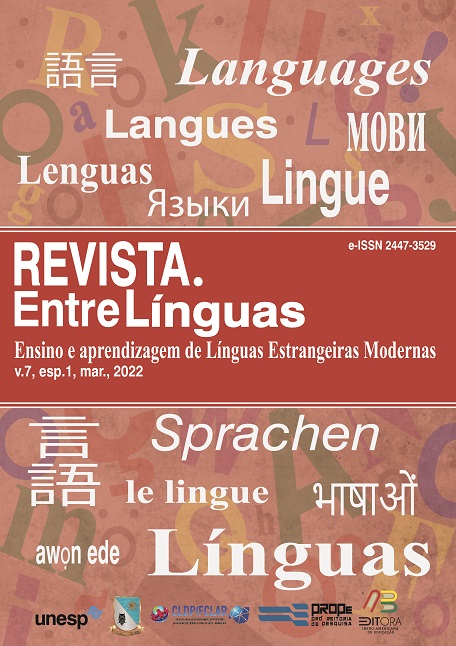Development of intercultural competence in foreign language classes at the medical university
DOI :
https://doi.org/10.29051/el.v8iesp.1.16921Mots-clés :
Language for specific purposes, Intercultural competence, Medical university, Foreign language, Project methodRésumé
This article describes the experience of using the project method in foreign language classes at the medical university. Using the example of the implementation of the project "Medical Education and Healthcare Abroad", the development of intercultural competence and its role in teaching a foreign language are examined. The features of the development of intercultural competence at the non-linguistic university are noted. The participation of an expert (teacher of the Department of Public Health and Healthcare) gives this project an interdisciplinary character, and also increases students’ motivation. This project allows to work on four aspects described in the Common European Framework of Reference for Languages (CEFR): listening, reading, writing and speaking. The use of self-assessment and peer assessment helps to develop critical thinking and allows students to improve their own projects. This project can be implemented in groups where students master a foreign language at different levels.
Téléchargements
Références
AGUILAR, M. Integrating intercultural competence in ESP and EMI: From theory to practice. ESP Today, v. 6, n. 1, p. 25-43, 2018. Available in: https://upcommons.upc.edu/handle/2117/125706. Access in: 17 Apr. 2021
BYRAM, M. Twenty-five years on – from cultural studies to intercultural citizenship. Language, Culture and Curriculum, v. 27, n. 3, p. 209-225, 2014. Available in: https://www.tandfonline.com/doi/abs/10.1080/07908318.2014.974329. Access in: 19 Feb. 2021
BYRAM, M.; GRIBKOVA, B.; STARKEY, H. Developing the intercultural dimension in language teaching. Strasbourg: Council of Europe, 2002. Available in: https://discovery.ucl.ac.uk/id/eprint/1562524/1/Starkey_InterculturalDimensionByram.pdf. Access in: 20 Jan. 2021.
CLOUET, R. The intercultural dimension of English as an Academic Lingua Franca (EALF) in scientific Publications. Revista de Lenguas para Fines Específicos, v. 23, n. 2, p. 313-333, 2017. Available in: https://ojsspdc.ulpgc.es/ojs/index.php/LFE/article/view/814. Access in: 17 Jan. 2021.
CUQ, J. P.; GRUCA, I. Didactic course of French as a foreign and second language. Paris: PUG, 2003.
FANTINI, A.; TIRMIZI, A. Exploring and assessing intercultural competence. St. Louis: Washington University, 2007.
GALISSON, R. From language to culture through words. Paris: CLE International, 1991.
HOLMES, P.; O’NEILL, G. Developing and evaluating intercultural competence: Ethnographies of intercultural encounters. International Journal of Intercultural Relations, v. 36, n. 5, p. 707-718, 2012. Available in: https://www.sciencedirect.com/science/article/abs/pii/S0147176712000508. Access in: 10 Mar. 2021.
JOHNS, A.; DUDLEY-EVANS, T. English for specific purposes: International in scope, specific in purpose. TESOL Quarterly, v. 25, n. 2, p. 297-314, 1991. Available in: https://onlinelibrary.wiley.com/doi/abs/10.2307/3587465. Access in: 08 Apr. 2021.
LINDNER, R. Introducing a Micro-Skills Approach to Intercultural Learning to an English for Specific Purposes Course for Students of Sociology. Scripta Manent, v. 5, n. 1-2, p. 9-24, 2010. Available in: https://scriptamanent.sdutsj.edus.si/ScriptaManent/article/view/75/61. Access in: 22 Feb. 2020.
LUKA, I. Development of Students Intercultural Competence at the Level. Polish Journal of Applied Psychology, v. 5, n. 1, p. 97-111, 2007. Available in: https://www.researchgate.net/publication/228862068_Development_of_Students'_Intercultural_Competence_at_the_Tertiary_Level. Access in: 14 Feb. 2020.
MANGIANTE, J. M.; PARPETTE, C. French for specific purposes, from the needs analysis to the development of a course. Paris: Hachette, 2004.
MCKAY, L. S. Teaching English as an International language. Oxford: Oxford University Press, v. 7, n. 1, 2002. Available in: http://www.tesl-ej.org/wordpress/issues/volume7/ej25/ej25r5/?wscr=. Access in: 11 Mar. 2021.
PORCHER, L. Foreign language teaching. Paris: Hachette, 2004.
PORCHER, L. Language learning and intercultural skills. In: DEMORGON, J.; LIPIANSKY, E. M. Guide de l'interculturel en formation. Paris: Retz, 1996.
TANG, H. V. Constructing a competence model for international professionals in the MICE industry: An analytic hierarchy process approach. Journal of Hospitality, Leisure, Sport & Tourism Education, v. 15, p. 34-49, 2014. Available in: https://www.sciencedirect.com/science/article/pii/S1473837614000124. Access in: 11 Mar. 2021.
XU, T.; YANN, L. Pedagogy of French for specific purposes in a Chinese medicine university: Research and application attempts in the third year. Synergies Chine, n. 3, p. 95-105, 2008.
ZORANYAN, M. The importance of teaching intercultural communication to ESP and BE students. IBSU Scientific Journal, v. 2, n. 1, p. 128–134, 2008. Available in: https://core.ac.uk/download/pdf/6454175.pdf. Access in: 17 Jan. 2021
Téléchargements
Publiée
Comment citer
Numéro
Rubrique
Licence

Ce travail est disponible sous licence Creative Commons Attribution - Pas d’Utilisation Commerciale - Partage dans les Mêmes Conditions 4.0 International.
Os manuscritos aceitos e publicados são de propriedade da Revista EntreLínguas. Os artigos publicados e as referências citadas na Revista EntreLínguas são de inteira responsabilidade de seus autores.
Transferência de direitos autorais – autorização para publicação
Caso o artigo submetido seja aprovado para publicação, já fica acordado que o(s) autor(es) autoriza(m) a UNESP a reproduzi-lo e publicá-lo na EntreLínguas, entendendo-se os termos “reprodução” e “publicação” conforme definição respectivamente dos incisos VI e I do artigo 5° da Lei 9610/98. O artigo poderá ser acessado pela rede mundial de computadores (Internet), sendo permitidas, a título gratuito, a consulta e a reprodução de exemplar do artigo para uso próprio de quem a consulta, desde que haja a citação ao texto consultado. Essa autorização de publicação 328 EntreLínguas, Araraquara, v. 1, n .2, p. 323-328, jul./dez. 2015 não tem limitação de tempo, ficando a UNESP responsável pela manutenção da identificação do(s) autor(es) do artigo. Os artigos publicados e as referências citadas na Revista EntreLínguas são de inteira responsabilidade de seus autores.











